Metal Spinnig, also called “Flow Forming” is the process of fixing flat or hollow billets onto the mold of a spinning machine. While the billets rotate on the bed spindle, a spinning wheel or driving rod is used to apply pressure to the billets, causing local plastic deformation.

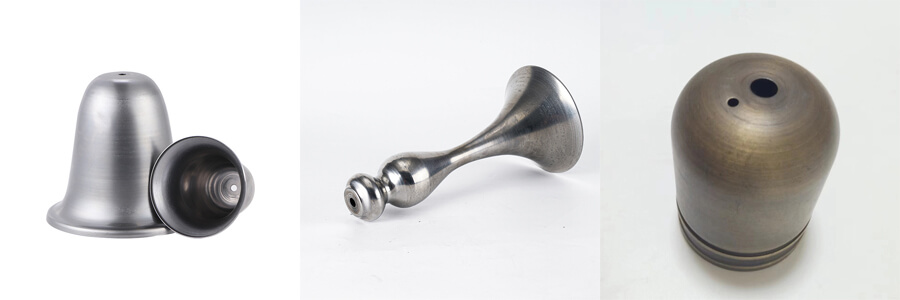
Metal Spinning from Yixing Technology is an advanced process that combines the characteristics of forging, extrusion, stretching, bending, ring rolling, cross rolling, and roll extrusion, with minimal or no cutting processing. Metal cylinder billets, flat billets, or prefabricated billets are tightly pressed onto the core mold of the spinning machine with a tail top, and the spindle drives the core rod and billet to rotate. At the same time, the spinning wheel squeezes the material onto the rotating core mold from one side of the blank, causing continuous plastic deformation of the material point by point, thereby obtaining hollow rotating parts with various busbar shapes.
Yixing Technology can do Cone spinning, Spherical spinning, Cylinder spinning which is widely used in different industries like instruments, ball valves, machinery, aerospace, automotive etc.
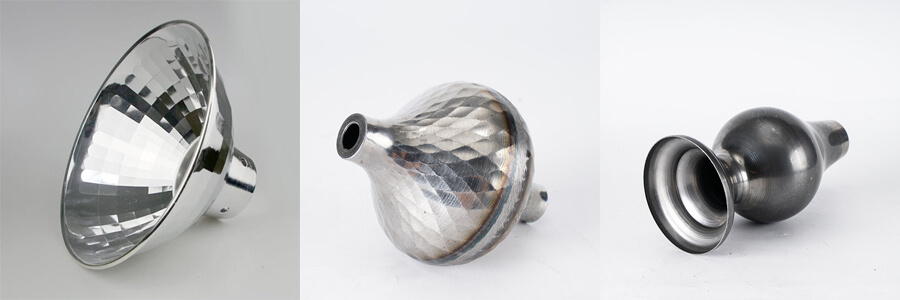
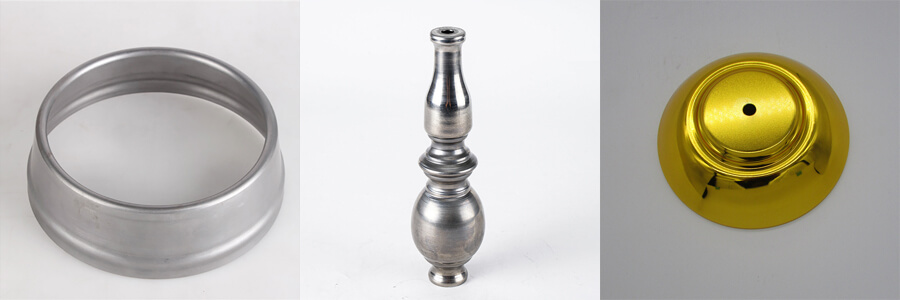
Yixing Technology provide precision Metal Spinning Services, which is widely used in fields such as aerospace, automotive, nuclear power, and electronics. For example, in automobile manufacturing, car wheels, diffusers, oxygen sensor components, etc. can all be produced using spinning technology. In the aerospace field, spinning technology is used to produce high-precision parts such as aircraft engine turbine blowers and rocket engine turbine pumps.

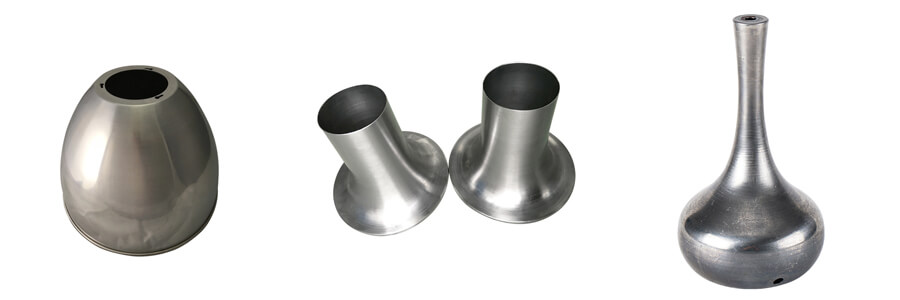


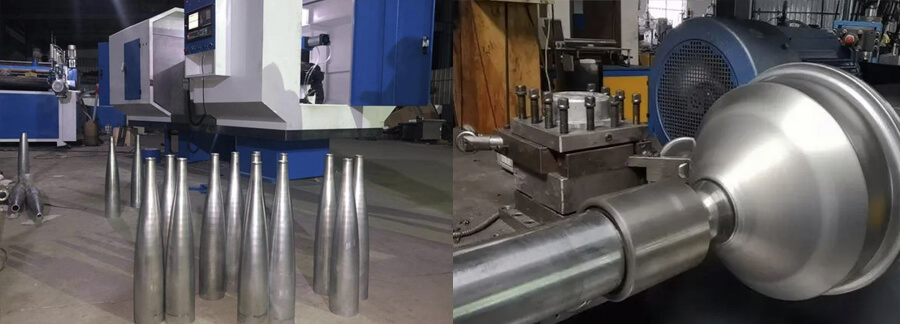

Expert Metal Forming Solutions: Yixing Technology is a professional sheet metal forming manufacturer engaged in CNC metal spinning parts, stamping parts and deep drawing parts with high cost-effectiveness, high precision, and high stability.

Tailored Metal Spinning Services: Yixing Technology provides custom metal spinning sevices, which can customize various special-shaped spinning parts according to customer drawings. Sheet metal material includes copper, iron, aluminum, stainless steel, and can be made with a diameter range of up to 1500mm. The thickness of the sheet metal spinning ranges from 0.5 to 10mm.

Versatile Applications and Finishes: Yixing Technology makes various lamp copper shell, floor lamp panel, lamp cup, pot, elliptical heads etc by metal spinning. Surface treatment like powder coating, anodization, plating, polishing etc can also be done per customers' requirements.

1. Fix the cut circular metal plate onto the machine core rod.
2. The core rod drives the circular metal sheet to rotate at high speed, and the tool with a rotating wheel begins to press the metal surface until the metal sheet fully fits into the inner wall of the mold and is formed.
3. After the molding is completed, the core rod is taken out, and the top and bottom of the part are cut off for demolding.
Both spinning forming and deep drawing can shape the sheet metal, with specific differences and advantages as follows:
1. Principle difference:
Spinning forming is controlled by the path of the cutting wheel to control the flow and deformation of the sheet metal, while the deep drawing controls the flow of the sheet metal through the combination of convex and concave molds.
2. Mold cost difference:
The deep drawing mold cost is usually 3-6 times that of metal spinning, and the manufacturing cycle of spinning molds is also shorter.
3. Material difference:
The thinning rate of spinning is usually about 30%, while that of deep drawing is about 10%. Deep drawing requires about 5-10mm of edge pressing material, which requires a higher material cost.
4. Production speed:
With deep drawing or stamping mold, the production speed is much faster than metal spinning. Metal spinning’ speed for one part is relatively slow.
5. Product difference:
In terms of the surface, the spinning marks are distributed in a circular pattern, while the stretching marks are distributed in a vertical line; In terms of strength, the strength of spun products is much better than that of stamping.
In short, conventional spinning emphasizes concave shapes, while strong spinning emphasizes thinning and lengthening.
Ordinary spinning is a spinning forming process that mainly changes the shape of the billet, with the wall thickness basically unchanged or less changed. Ordinary spinning mainly shapes workpieces by changing the diameter size of the sheet metal. It is a non cutting forming process for processing thin-walled rotating bodies, which is formed by spinning the rotating metal circular plate or preform through feed motion of the spinning wheel.
Power spinning (also known as thinning spinning) originates from ordinary spinning, in which not only changes the shape of the blank but also significantly reduces its wall thickness during the spinning process. The difference between thinning spinning and ordinary spinning is that thinning spinning belongs to the category of volume deformation. During the deformation process, the main thing is to reduce the wall thickness while keeping the volume of the billet basically unchanged. The shape of the finished product is completely determined by the size of the core mold, and the accuracy of the finished product size depends on the reasonable matching of process parameters. When using strong spinning for cylindrical parts, only the outer diameter is reduced without changing the inner diameter (the opposite is true for internal spinning). Due to the reduction of the wall thickness of the blank by strong spinning, a large amount of deformation is allowed in one spinning, which greatly improves the production efficiency of strong spinning compared to ordinary spinning. Its applicability is also greatly expanded, but the corresponding strong spinning requires a larger equipment power.
The motion principle of CNC spinning and manual spinning in the product forming process is the same. The clamping force is provided by the tail top, which drives the material sheet to rotate together with the spindle. The cutting wheel extends the material sheet from point to line and from line to surface according to the predetermined cutting path, and finally forms. The difference lies in the path that the CNC spinning machine controls the cutting wheel during the spinning process, as well as the gap between the cutting wheel and the mold. Due to the high operating accuracy, good equipment rigidity, and large processing force of CNC machine tools, the manufactured products have good consistency, stable production, and can effectively control the accuracy of the products; In the process of manual spinning and forming, the cutting path of the cutting wheel is determined by manually controlling the cutting rod, and there are differences in the cutting path and gap between each product, resulting in unstable precision of batch products.
When the thickness of the spun material exceeds a certain range (iron exceeds 1.2mm, aluminum exceeds 1.5mm, and stainless steel exceeds 1mm), manual force cannot support the required processing force during spinning, which can easily lead to product scrap. When manually spinning aluminum and iron products for thin parts, the outer wall surface of the processed product will be better than that of CNC spinning. But in recent years, with the continuous improvement of process technology, the outer wall surface of CNC spinning products has become very similar to manual spinning.